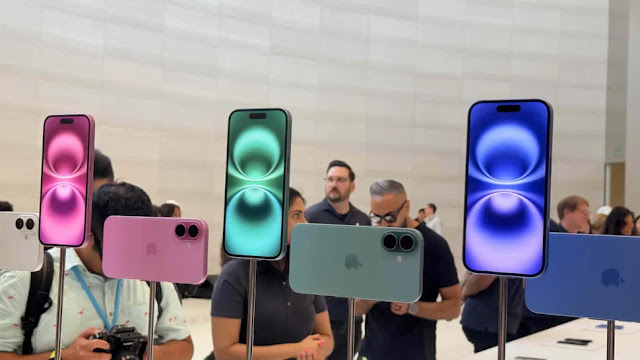Practical Examination: Review of the iPhone 16 – Featuring New Buttons, Enhanced Colors, Upgraded Processor, and Increased 'Pro' Capabilities.
New colors and a Camera Control button elevate the new 'base' iPhone
The color options are truly remarkable, best characterized as 'fun' for the majority of the shades. The Ultramarine, which is a blend of blues (though it should not be referred to simply as blue), along with pink and teal, collectively rejuvenate the iPhone's color palette and are visually appealing. However, it is likely that Pro buyers may feel somewhat disappointed with these vibrant selections, especially considering the more subdued colors available for the Pro and Pro Max models.
No matter which color one chooses, it is most prominently displayed on the back of the device, which also serves as the backdrop for the newly designed main camera bump. The two lenses are now positioned vertically instead of diagonally, featuring a 48-megapixel primary lens alongside a 12-megapixel ultra-wide lens. This new arrangement will enable the iPhone to capture spatial video, which can be viewed on the Apple Vision Pro.
Additional physical modifications can be observed on the sides of the device. This year, the Action Button has been introduced to the standard iPhones, positioned above the volume rocker. I consider this a positive enhancement, akin to the new customization options available in iOS 18, as it serves as a customizable button on your iPhone. For instance, you might choose to use it to unlock your vehicle, play a particular rendition of "Born to Run" by Bruce Springsteen, create a personalized shortcut, or select from preset functions such as activating the flashlight or opening the camera.
It is unclear why you would configure it to activate the camera, especially given that the iPhone 16 features a newly designed Camera Control button located on the left side. This button is ideally situated; when the iPhone 16 is held horizontally, it is positioned at the top-right, resembling the layout of most cameras. A single press opens the camera, while a second press captures the image. However, this button offers more than just a basic function. By swiping left or right, users can zoom in or out, and a gentle press allows for switching between various shooting modes and effects. This functionality is impressive, and I look forward to exploring it further.
In addition to the aforementioned modifications, the iPhone 16 bears a strong resemblance to its predecessor, the iPhone 15. Its aluminum construction ensures a robust feel without adding excessive weight. To an untrained observer, the device appears predominantly as a 6.1-inch display, featuring a vibrant and sharp OLED panel. However, it remains at a refresh rate of 60Hz, which may disappoint those accustomed to the fluidity of a 120Hz screen; nonetheless, users who have not experienced the latter may not find this to be a significant drawback.
Furthermore, the Dynamic Island is positioned at the top of the display, facilitating extensive use of Live Activities. During my brief interaction with the device, the iPhone 16 exhibited impressive responsiveness when launching applications, experimenting with the new buttons, and engaging in various games. Notably, it is equipped with a completely new chip, the Apple A18, which is designed to handle everyday tasks efficiently and will be prepared to support Apple Intelligence features upon their release.
Addressing a key point of interest, the iPhone 16 will come pre-installed with iOS 18; however, it will not include any Apple Intelligence features initially. The first of these features, including Writing Tools and Photo Cleanup, is expected to be available with the release of iOS 18.1 in October.
In summary, my initial impressions of the iPhone 16 indicate that it is a powerful device with additional functional buttons, all within a familiar aesthetic. While the overall experience may closely mirror that of the iPhone 15, I am eager to see how it enhances the user experience, particularly in comparison to earlier models. At the very least, the new iPhones offer a more vibrant color palette, which is certainly a positive development.
- Starts at $799 / £799 / AU$1,399
- Pre-orders open on September 13, shipping from September 20
| Storage | US price | UK price | AU price |
|---|---|---|---|
| 128GB | $799 | £799 | AU$1,399 |
| 256GB | $899 | £899 | AU$1,599 |
| 512GB | $1,099 | £1,099 | AU$1,949 |
| iPhone 16 | |
|---|---|
| Dimensions: | 147.6 x 71.6 x 7.8mm |
| Weight: | 170g |
| Display: | 6.1-inch OLED |
| Resolution: | 2556 x 1179 pixels |
| Refresh rate: | 60Hz |
| Chipset: | A18 |
| Rear cameras: | 48MP main (26 mm, f/1.6), 12MP ultra-wide (13 mm, f/2.2) |
| Front camera: | 12MP (f/1.9) |
| Storage: | 128GB, 256GB, 512GB |





